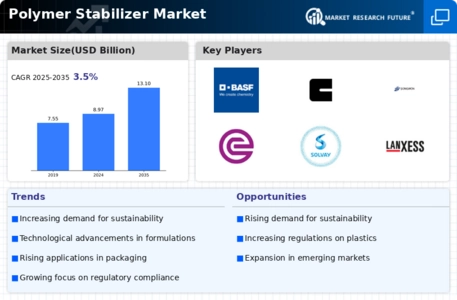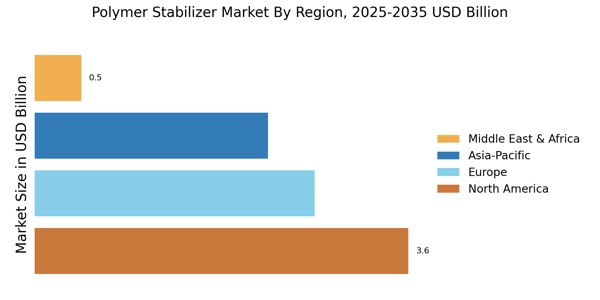Growth in End-Use Industries
The Polymer Stabilizer Market is poised for growth due to the expansion of end-use industries such as packaging, electronics, and consumer goods. The packaging sector, in particular, is witnessing a surge in demand for flexible and rigid packaging solutions, which require effective stabilizers to maintain product integrity. According to recent estimates, the packaging industry is expected to grow at a rate of around 5% annually, thereby driving the need for advanced polymer stabilizers. Additionally, the electronics industry is increasingly utilizing polymers for insulation and components, further propelling the demand for stabilizers that enhance thermal and electrical properties. This growth across various sectors indicates a robust market potential for polymer stabilizers, as manufacturers seek to optimize their products for performance and sustainability.
Increasing Focus on Sustainability
The Polymer Stabilizer Market is witnessing a paradigm shift towards sustainability, driven by consumer preferences and corporate responsibility initiatives. Companies are increasingly seeking stabilizers that not only enhance product performance but also align with environmental goals. This trend is evident in the rising demand for bio-based and biodegradable stabilizers, which are perceived as more sustainable alternatives to traditional petrochemical-based options. Market data suggests that the demand for sustainable polymer solutions is expected to grow at a rate of approximately 6% annually. As a result, manufacturers are likely to invest in research and development to create innovative stabilizers that meet these sustainability criteria, thereby positioning themselves favorably in a competitive market.
Rising Demand for Durable Materials
The Polymer Stabilizer Market experiences a notable increase in demand for durable materials across various sectors, including automotive, construction, and packaging. As industries strive for longevity and performance, the need for stabilizers that enhance the durability of polymers becomes paramount. For instance, the automotive sector is projected to grow significantly, with a compound annual growth rate of approximately 4.5% over the next few years. This growth is likely to drive the demand for polymer stabilizers that can withstand harsh environmental conditions, thereby ensuring product longevity. Consequently, manufacturers are focusing on developing advanced stabilizers that not only improve the mechanical properties of polymers but also contribute to sustainability efforts by reducing waste and enhancing recyclability.
Regulatory Compliance and Safety Standards
The Polymer Stabilizer Market is increasingly influenced by stringent regulatory compliance and safety standards. Governments and regulatory bodies are implementing more rigorous guidelines to ensure the safety and environmental impact of polymer products. This trend compels manufacturers to invest in high-quality stabilizers that meet these evolving standards. For example, the European Union's REACH regulation mandates that chemical substances, including polymer stabilizers, must be registered and evaluated for safety. As a result, companies are likely to prioritize the development of stabilizers that not only comply with regulations but also enhance the safety profile of their products. This focus on compliance may lead to increased research and development efforts, ultimately fostering innovation within the polymer stabilizer sector.
Technological Innovations in Polymer Chemistry
The Polymer Stabilizer Market is significantly impacted by technological innovations in polymer chemistry. Advances in formulation techniques and the development of new stabilizing agents are enabling manufacturers to create more effective and efficient stabilizers. Innovations such as nanotechnology and bio-based stabilizers are gaining traction, offering enhanced performance characteristics and reduced environmental impact. For instance, the introduction of nanocomposites has shown promise in improving the mechanical strength and thermal stability of polymers. As these technologies evolve, they are likely to reshape the landscape of the polymer stabilizer market, providing opportunities for companies to differentiate their products and meet the growing demand for high-performance materials.


















Leave a Comment